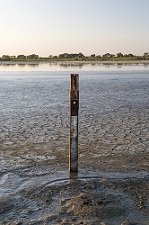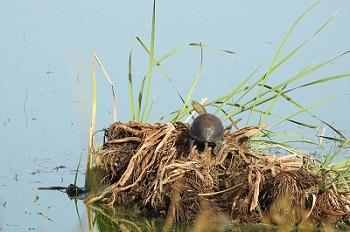This Friday, the ICTS – Doñana Biological Reserve has installed a new camera in the Doñana National Park to monitor the drying of Santa Olalla, the largest lagoon in the protected natural area. This will predictably happen in mid-August, a couple of weeks earlier than last year. Since the Doñana Biological Station – CSIC has records, this lagoon has never dried up for two consecutive years, which demonstrates the critical situation of the Doñana lagoon system.
Santa Olalla is the largest lagoon in Doñana and is mainly fed by groundwater from the aquifer. It is considered a permanent lagoon because, unlike other smaller ponds, it maintains a permanent water body during the entire year. Or at least, it did. At the end of August 2022, closing the hydrological cycle, Santa Olalla was suffering one of the most intense desiccations ever. The lagoon had already dried up completely on two occasions, but never after several straight years of low rainfall. The dramatic aerial image of the large basin completely dry went around the world.
This year the same image is likely to be repeated much earlier than last year, showing the critical situation of the Doñana lagoon system, which shelters a great biodiversity and represents one of the most valuable ecosystems of the protected area. In response to this, the ICTS – Doñana Biological Reserve has decided to install a camera to periodically monitor the state of the lagoon. Anyone can watch the live-streaming through the website: http://icts.ebd.csic.es/cameras.
Scientific evidence shows that drought is one of the most serious problems affecting the Doñana lagoon system, as is also the overexploitation of the aquifer that sustains it. In a recent study, the Doñana Biological Station – CSIC found that almost 60% of the lagoons that existed in the 1980s have already disappeared. In addition, the same study reveals that 80% of lagoons dry up earlier than expected due to rainfall and 84% are flooded less than expected due to climatic conditions, facts that show that human activity is altering their natural balance.
In another study, the Doñana Biological Station - CSIC has revealed that pond basin colonization by terrestrial vegetation due to low flooding is a good indicator of their deterioration. Terrestrial vegetation has fully invaded many of the lagoons of Doñana, which testifies to their impossible recovery. In recent years, aerial images show that terrestrial vegetation has also begun to colonize Santa Olalla.

A la izquierda se puede observar una vista aérea de la laguna de Santa Olalla en agosto de 2014 (Héctor Garrido / EBD-CSIC). A la derecha otra imagen aérea muestra la misma laguna en agosto de 2022 (JL Arroyo / EBD-CSIC). En la imagen de 2014, se aprecian las arenas blancas en el fondo seco, pero en 2022 se aprecia cómo la vegetación terrestre ha ido penetrando en la laguna, debido al menor grado de inundación experimentado en los últimos años.
http://icts.ebd.csic.es/cameras

 Live stream will show the dry up of Santa Olalla for second consecutive year
Live stream will show the dry up of Santa Olalla for second consecutive year

